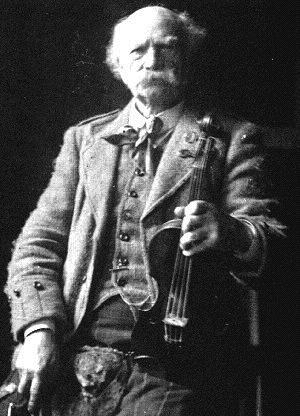
James Scott Skinner
James Scott Skinner (1843-1927) was a famous Scottish fiddler and composer who played with a definitive classical style that influenced contemporary and subsequent Scottish fiddlers and their music for over a century. In addition, Skinner was quick to use the technology of the post-Victorian era and had recorded more than 30 tunes by February, 1910, on the new medium of the cylinder recording. He was a consummate showman, and had the technique to back it up, though his once-great reputation is somewhat diminished nowadays in part due to accusations of his being pompous and ego-centric (a perception unfortunately not helped by his own memoirs).
Skinner recounted his childhood as harsh and somewhat deprived, driven by the death of his father when he was a baby and his mother’s subsequent unhappy remarriage.
His mother apparently was a strict woman who brooked no childish disobedience, and reinforced her beliefs with the rod. He was similarly ill-treated by a schoolmaster when he came of school age. James’ brother Sandy, older and an accomplished musician, began to teach him fiddle and cello when he was six years old, but he again was remembered as a harsh taskmaster who also could mete out “humiliating punishment.” The youngster was, by all accounts, a gifted and precocious child who, one can imagine, took to music as an escape and a salve to battered self-esteem. At the age of 8 he was accompanying a famous Deeside fiddler and composer, Peter Milne, who became a mentor and whom Skinner said was “practically a father to me.” Milne earned a meager living giving lessons, playing gigs, and later busking on the Firth ferry, and Skinner recalled: “It was nothing unusual for Peter and me to trudge eight or ten weary miles on a slushy wet night in order to fulfill a barn engagement". One night he came home so exhausted he collapsed in the doorway with his cello. He had been too tired to lift the latch, but fell dead asleep instead, remaining there until he was found by his mother several hours later.
At puberty, Skinner was performing with other children in an orchestra called Dr. Mark’s Little Men, which traveled the British Isles. This enterprise lasted until he was in his late teens—they even played before Queen Victoria at Buckingham Palace in 1858—by which time Skinner had acquired the ability to read music and a trained classical technique plus valuable experience at concertizing and how to promote one’s music for gain. Soon after, Skinner began to study with a dancing master named William Scott, and incorporated this admired individual’s name into his own, thus becoming James Scott Skinner. This was followed by a brief foray into blackface minstrelsy (under the name ‘Mr. Grace Egerton’) before he found employment at Balmoral Castle, the summer residence of Queen Victoria, teaching the tenantry to dance. It was around this time that he finally found firm musical setting with the publication of his first collections for the fiddle, Twelve New Strathspeys (1865), followed by Thirty New Strathspeys and Reels (1868). He also forwarded his personal life by marrying a dancer he met at Balmoral, Jane Stuart, and father a daughter, Jeanie, and a son, Manson.
Skinner made his living in much the same way his first mentor, Peter Milne, did: by teaching and performing whenever he could, although he was rather more successful at engaging the gentry to be his patrons. His performing repertoire consisted of classical pieces, traditional Scottish music and his own compositions, and, after more than a decade of work, he “had the patronage of all the big private families in Ross-Shire, Inverness-shire, Elginshire and Bannffshire.” He was earning steady money, and making a comfortable living when tragedy struck. In 1885 his wife Jane was admitted to the Elgin Lunatic Asylum, diagnosed with “excitement,” never to be released (she died in 1899). Skinner tried to keep up payments to her, but had his own financial troubles as a result of the dissolution of the household, and Jane died a pauper. Soon after Jane’s hospitalization Skinner’s brother Sandy died, although his widow, Madame de Lenglee, then joined Skinner’s household as governess and dance teacher.
Aberdeen became his home as he worked to pull his life back together. During a tour of America in 1893, however, he appeared to have an epiphany of sorts and declared to all that he would give up trying to make a living teaching dancing, and would concentrate solely on a career as a solo violinist. He also adopted the kilt as his stage dress, committing himself to an identity as a Scot and to Scottish music. Skinner had kept up with composition and publication, releasing The Miller O'Hirn Collection (1881), The Beauties of the Ballroom (1882), The Elgin Collection (1884), The Logie Collection (1888) and The Scottish Violinist (1900). All except the latter were prior to his American epiphany, indicating that his determination was not all that newfound—he had been playing and composing Scottish music all along—and may have had more to do with aging knees for dancing and opportunities for self-promotion and marketing that became clear to him while he was in America.
After the turn of the century Skinner’s career peaked. He married for a second time, a union that lasted ten years before his wife moved on her own to Rhodesia. His most famous collection, The Harp and Claymore, was published in 1904, and he found his cylinder recordings (made in 1905 and 1910) lucrative for a time. His fame allowed him to tour repeatedly until he was quite elderly. In 1925, at the age of 82, he played at the Royal Albert Hall and then went on a second tour of America. Unfortunately, the tour was not successful, and the fiddler died in his home in Aberdeen soon after, in 1927.